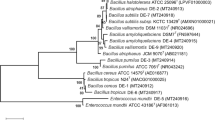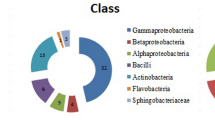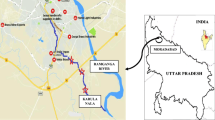Abstract
Rhizobacteria can enhance biomass production and heavy metal tolerance of plants under the stress environment. The aim of this study was to collect soil samples from different industrial sites followed by their heavy metal analysis. After performing the ICP-AES analysis of soil samples from seven different sites, bacterial strains were isolated from the soil samples of most polluted (heavy metal) site. Phylogenetic analysis of isolates based on 16S rDNA sequences showed that the isolates belonged to four species: Bacillus thuringiensis, Azotobacter chroococcum, Paenibacillus ehimensis and Pseudomonas pseudoalcaligenes. Plant growth promoting activities; siderophore production, indole acetic acid production, HCN production, and phosphate solubilisation were assayed in vitro, and statistically analysis done by using ANOVA analysis and Tukey’s Honestly Significant Difference test (p ≤ 0.05). Plant growth-promoting characteristics of isolated strains were higher compared to the control Pseudomonas fluorescens (NICM 5096). In vitro study was performed to check resistance against two heavy metals of isolates. It was observed that isolated bacterial strains have higher heavy metal resistance as compared to control E. coli (NICM 2563). These isolates may cause pathogenic effects, so to avoid this risk, their antibacterial susceptibility was checked against eight antibiotics. Among the eight antibiotics, Ciprofloxacin-1 has shown higher inhibition against all the isolated bacterial strains.


Similar content being viewed by others
References
Ahemad M, Khan MS (2012a) Effect of fungicides on plant growth promoting activities of phosphate solubilizing Pseudomonas putida isolated from mustard (Brassica compestris) rhizosphere. Chemosphere 86:945–950
Ahemad M, Khan MS (2012b) Ecological assessment of biotoxicity of pesticides towards plant growth promoting activities of pea (Pisum sativum)-specific Rhizobiumsp strain MRP1. Emir J Food Agric 24:334–343
Ahemad M, Khan MS (2012c) Evaluation of plant growth promoting activities of rhizobacterium Pseudomonas putida under herbicide-stress. Ann Microbiol 62:1531–1540
Anderson T (1990) Effects of carbon nitrogen ratio and oxygen and the growth kinetics of Bacillus thuringienesis and yield of bio-insecticidal crystal protein. M.Sc Thesis, The University of Western Ontario, London, Canada
Aneja KR (1993) Experiments in microbiology plant pathology and tissue culture. Wishwa Prakashan, New Delhi
Bakker AW, Schipper B (1987) Microbial cyanide production in the rhizosphere in relation to potato yield reduction and Pseudomonas spp mediated plant growth stimulation. Soil Biol Biochem 19:451–457
Barakat MA (2011) New trends in removing heavy metals from industrial wastewater. Arab J Chem 4:361–377
Barzanti R, Ozino F, Bazzicalupo M et al (2007) Isolation and characterization of endophytic bacteria from the nickel hyperaccumulator plant Alyssum bertolonii. Microb Ecol 53:306–316
Belimov AA, Hontzeas N, Safronova VI et al (2005) Cadmium-tolerant plant growth promoting rhizobacteria associated with the roots of Indian mustard (Brassica junceal Czern). Soil Biol Biochem 37:241–250
Burd GI, Dixon DG, Glick BR (2000) Plant growth promoting bacteria that decrease heavy metal toxicity in plants. Can J Microbiol 46:237–245
Charlesworth S, Everett M, mccarthy R et al (2003) A comparative study of heavy metal concentration and distribution in deposite d street dusts in a large and a small urban area: birmingham and Coventry West Midlands UK. Environ Int 29:563–573
Deka AK, Azad P (2006) Isolation of rhizobium strains: cultural and biochemical characteristics. J Leg Res 29:209–212
Dell’Amico E, Cavalca L, Andreoni V (2008) Improvement of Brassica napus growth under cadmium stress by cadmium resistant rhizobacteria. Soil Biol Biochem 40:74–84
Forstner U, Wittman GTW (1983) Metal pollution in the aquatic environment. Springer, Berlin
Freitas JR, Banerjee R, Germida JJ (1997) Phosphate solubilizing rhizobacteria enhance the growth and yield but not phosphorus uptake of canola (Brassica napus L). Biol Fertil soil. 24:358–364
Hynes RK, Leung GC, Hirkala DL et al (2008) Isolation selection and characterization of beneficial rhizobacteria from pea lentil and chickpea grown in Western Canada. Can J Microbiol 54:248–258
Idris R, Trifonova R, Puschenreiter M et al (2004) Bacterial communities associated with flowering plants of the Ni hyperaccumulator Thlaspi goesingense. Appl Environ Micobiol 70:2667–2677
Irha N, Slet J, Petersell V (2003) Effect of heavy metals and PAH on soil assessed via dehydrogenase assay. Environ Int 28:779–782
Jiang CY, Sheng XF, Qian M et al (2008) Isolation and characterization of a heavy metal-resistant Burkholderia sp from heavy metal-contaminated paddy field soil and its potential in promoting plant growth and heavy metal accumulation in metal-polluted soil. Chemosphere 72:157–164
Kim JY, Myung JH, Ahn JS et al (1998) Heavy metal speciation in dusts and stream sediments in the Taejon area, Korea. J Geochem Explor 64:409–419
Kishe MA, Machiwa JF (2003) Distribution of heavy metals in sediments of Mwanza Gulf of Lake Victoria, Tanzania. Environ Int 28:619–625
Kumar et al (2013) Spectroscopic methods for the detection of organophosphate pesticides—a preview. Curr World Environ 8:313–319
Kumar et al (2013) Thin-layer chromatography: comparative estimation of soil’s atrazine. Curr World Environ 8:469–473
Kumar et al (2015a) A review on sample preparation and chromatographic determination of acephate and methamidophos in different samples. Arab J Chem. doi:10.1016/j.arabjc.2014.12.007
Kumar et al (2015b) Interactions of atrazine with transition metal ions in aqueous media: experimental and computational approach. 3 Biotech. doi:10.1007/s13205-015-0281-x
Lakanen E, Ervio¨ R (1971) A comparison of eight extractants for the determination of plant available micronutrients on soil. Acta Agralia Fennica 123:223–232
Leharne S, Charlesworth D, Choudhry B (1992) A survey of metal levels in street dusts in an inner London neighbourhood. Environ Int 18:263–270
Loper JE, Schroth MN (1986) Influence of bacterial sources of indole-2-acetic acid on root elongation of sugar beet. J Phytopathol 76:386–389
Ma Y, Rajkumar M, Luo Y et al (2011) Inoculation of endophytic bacteria on host and non-host plants-effects on plant growth and Ni uptake. J Hazard Mater 195:230–237
Machiwa JF (1992) Heavy metal content in coastal sediments of Dares Salaam Tanzania. Environ Int 18:409–415
Piotrowska-Seget Z, Cycon´ M, Kozdrój J (2005) Metal-tolerant bacteria occurring in heavily polluted soil and mine spoil. Appl Soil Ecol 28:237–246
Powell LM, Wallis SC, Pease RJ et al (1987) A novel form of tissue-specific RNA processing produces apolipoprotein-B48 in intestine. Cell 50(6):831–840
Prasad R, Upadhyay N, Kumar V (2013) Simultaneous determination of seven carbamate pesticide residues in gram, wheat, lentil, soybean, fenugreek leaves and apple matrices. Microchem J 111:91–97
Rajkumar M, Freitas H (2008) Effects of inoculation of plant-growth promoting bacteria on Ni uptake by Indian mustard. Bioresour Technol 99:3491–3498
Russo A, Vettori L, Felici C et al (2008) Enhanced micro-propagation response and biocontrol effect of Azospirillum brasilensesp245 on Prunus cerasifera L Clone Mr S 2/5 plants. J Biotechnol 134:312–319
Saiki RK, Scharf S, Faloona F et al (1985) Enzymatic amplification of beta-globin genomic sequences and restriction site analysis for diagnosis of sickle cell anemia. Science 230:1350–1354
Sheng XF, Xia JJ (2006) Improvement of rape (Brassica napus) plant growth and cadmium uptake by cadmium-resistant bacteria. Chemosphere 64:1036–1042
Sheng XF, Xia JJ, Jiang CY et al (2008) Characterization of heavy metal-resistant endophytic bacteria from rape (Brassica napus) roots and their potential in promoting the growth and lead accumulation of rape. Environ Pollut 156:1164–1170
Sun LN, Zhang YF, He LY et al (2010) Genetic diversity and characterization of heavy metal-resistant-endophytic bacteria from two copper-tolerant plant species on copper mine wasteland. Bioresour Technol 101:501–509
Teintze M, Hussein MB, Barnes CL et al (1981) Structure of ferric pseudobactin a siderophore from a plant growth promoting Pseudomonas. J Biochem 20:6446–6457
Tian F, Ding Y, Zhu H et al (2009) Genetic diversity of siderophore-producing bacteria of tobacco rhizosphere. Braz J Microbiol 40:276–284
Tica D, Udovic M, Lestan D (2011) Immobilization of potentially toxic metals using different soil amendments. Chemosphere 85:577–583
Wani PA, Khan MS (2010) Bacillus species enhance growth parameters of chickpea (Cicer arietinum L) in chromium stressed soils. Food Chem Toxicol 48:3262–3267
Watanabe K, Baker PW (2000) Environmentally relevant microorganisms. J Biosci Bioeng 89:1–11
Wei B, Yang L (2010) A review of heavy metal contaminations in urban soils urban road dusts and agricultural soils from China. Microchem J 94:99–107
Author information
Authors and Affiliations
Corresponding author
Electronic supplementary material
Below is the link to the electronic supplementary material.
Rights and permissions
About this article
Cite this article
Kumar, V., Singh, S., Singh, J. et al. Potential of Plant Growth Promoting Traits by Bacteria Isolated from Heavy Metal Contaminated Soils. Bull Environ Contam Toxicol 94, 807–814 (2015). https://doi.org/10.1007/s00128-015-1523-7
Received:
Accepted:
Published:
Issue Date:
DOI: https://doi.org/10.1007/s00128-015-1523-7




